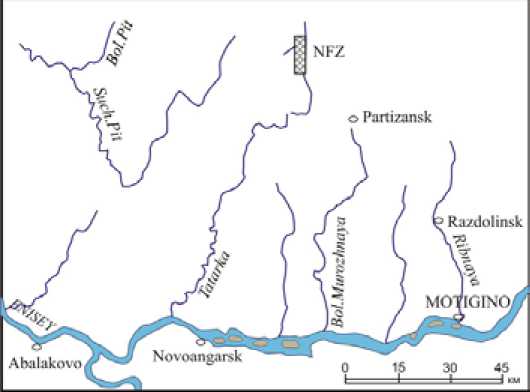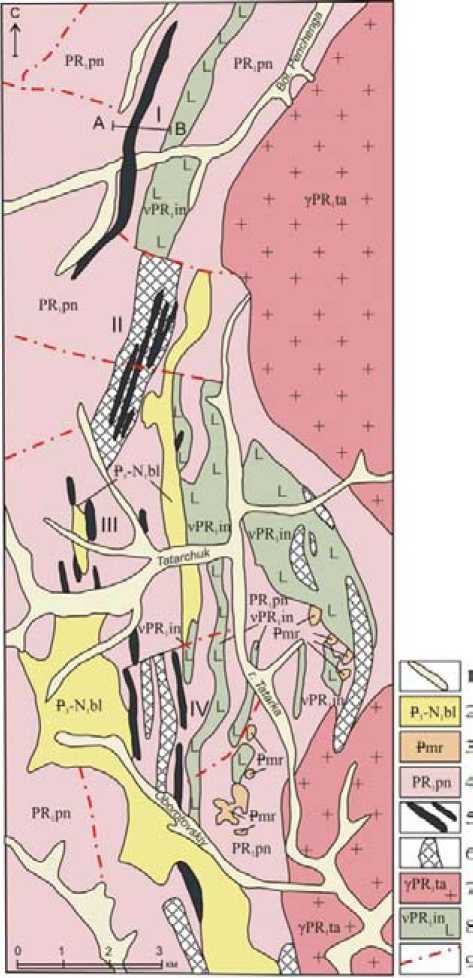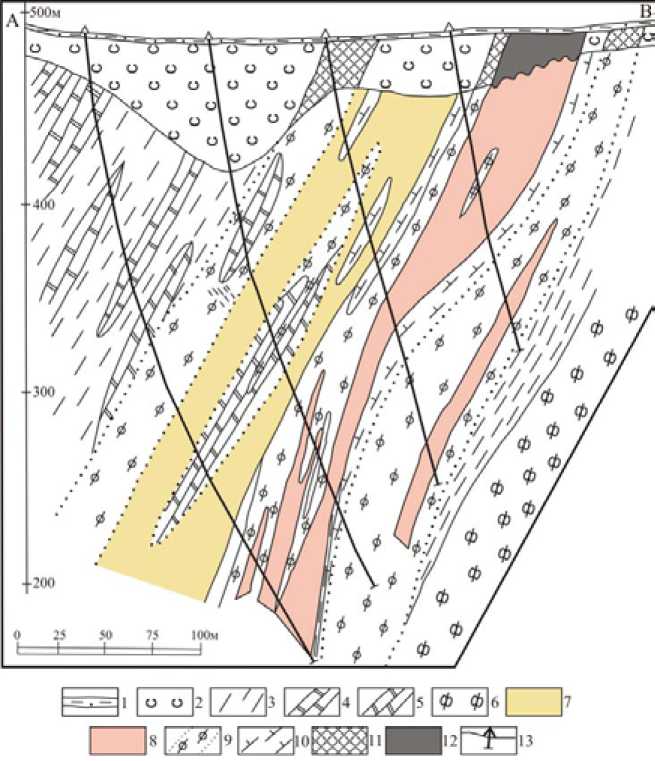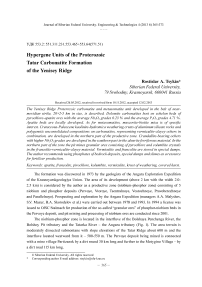Hypergene units of the Proterozoic Tatar carbonatite formation of the Yenisey Ridge
Автор: Tsykin Rostislav A.
Журнал: Журнал Сибирского федерального университета. Серия: Техника и технологии @technologies-sfu
Статья в выпуске: 4 т.6, 2013 года.
Бесплатный доступ
The Yenisey Ridge Proterozoic carbonatite and metasomatite unit developed in the belt of near-meridian strike, 20×2-5 km in size, is described. Dolomite carbonatites host en echelon beds of pyrochlore-apatite ores with the average Nb 2 O 5 grades 0.23 % and the average P 2 O 5 grades 4.71 %. Apatite beds are locally developed. As for metasomatites, muscovite-biotite mica is of specific interest. Cretaceous-Paleocene kaolinite-hydromica weathering crusts of aluminum silicate rocks and polygenetic unconsolidated compositions on carbonatites, representing vermiculite-clayey ochers in combination, are developed in the northern part of the productive zone. Crandallite-bearing ochers with higher Nb 2 O 5 grades are developed in the southern part in the aleurite ferriferous material. In the northern part of the zone the pit mines granular ores consisting of pyrochlore and columbite crystals in the francolite-vermiculite-clayey material. Vermiculite and francolite are stored in special dumps. The author recommends using phosphates of bedrock deposits, special dumps and slimes as a resource for fertilizer production.
Apatite, francolite, pirochlore, kolumbite, vermiculite, krust of weathering, covered karst
Короткий адрес: https://sciup.org/146114749
IDR: 146114749 | УДК: 553.2:
Текст научной статьи Hypergene units of the Proterozoic Tatar carbonatite formation of the Yenisey Ridge
The formation was discovered in 1973 by the geologists of the Angara Exploration Expedition of the Krasnoyarskgeologiya Union. The area of its development (above 2 km with the width 2.02.5 km) is considered by the author as a productive zone (niobium-phosphor zone) consisting of 5 niobium and phosphor deposits (Pervoye, Vtoroye, Tsentralnoye, Vostochnoye, Pravoberezhnoye and Parallelnoye). Prospecting and exploration by the Angara Expedition (managers A.A. Malyshev, S.V. Mazur, B.A. Skorodelov et al.) were carried out between 1978 and 1993. In 1994 a license was issued to OJSC Stalmach for production of the so-called “granular ores” of phosphor-niobium beds in the Pervoye deposit, and pit mining and processing of niobium ores are conducted since 2001.
The niobium-phosphor zone is located in the interfluve of the Bolshaya Penchenga River, the Bolshoy Pit tributary and the Tatarka River – the Angara tributary (Fig. 1). The area terrain is moderately dissected submontane with slope elevations of the Tatar Ridge about 600 m and the interfluve located westward from it – 500-550 m. The Pervoye deposit being mined is connected with a mine village Partizansk by a dirt round 30 km long and further to the Motygino Village – by a dirt road 115 km long.

Fig. 1. Location of the Tatar niobium-phosphate zone
Linear carbonatite and associated metasomatite bodies have near-meridian strike. Their absolute age defined with the uranium-lead method is within 1000-1700 mln. years. The hosting metamorphosed formations of the Penchenga suite of the Lower Proterozoic age are steeply inclined to the west, are complicated by asymmetric folds and are broken by disjunctive faults (Fig. 2). Calcite marbles, aposandstone quartzites, two-mica slates and calcareous quartz-biotite slates hosting marble lenses are traced in the suite section. The formations of the Penchenga suite are broken through by partially conformable amphibolitized gabbroids of the Indyglinsky Lower Proterozoic complex. Amphibolites suffered metasomatosis locally.
The niobium-phosphate mineralization researchers think that it is confined to the Tatar-Panimbinsky fault. Nonetheless, the latter is absent on geological maps of 1,000,000 and 500,000 scales for this area. The near-meridian permeability zone evidently existed in the Proterozoic age and was responsible for the formation of the carbonatite and metasomatite complex, but it did not function later. The outcrops of the Lower Proterozoic Penchenga suite are locally covered by coat-shaped layers of the Miocene Belskaya suite. The lower Murozhninskaya suite, according to its morphology (see Fig. 2) fills the covered karst forms. Bauxite and phosphate bodies are associated with it.
The niobium and phosphor mineralization is mainly present in carbonatites composed of ferriferous dolomite and forming a series of lens-shaped bodies up to 4-5 km long and 80-360 m wide [1]. They dip steeply to the west-north-west and are traced at the depth above 600 m without any pinching-out indicators (Fig. 3). Calcite carbonatites are oreless. Associated metasomatites are developed in exocontacts of carbatite bodies: on slates – phlogopite micaite and on amphibolites – amphibole-phlogopite rocks. Albitite and albite-amphibole aggregations are formed in the external metasomatosis zone. Calcite marbles are re-crystallized and impregnated with arfvedsonite, albite and apatite. Pyrrotite is a widely developed accessory mineral.
The detail petrographic and mineralogical studies of the Proterozoic Tatar carbonatite formation in the end of the Soviet period were conducted by the research officers of industry institutes of the USSR Ministry of Geology – A.V. Lapin et al [2]. In particular, they studied the

Fig. 2. Geological map of the Tatar niobium-phosphate zone: 1 – Quaternary valley formations, sands, clayey silts with fragments; 2 – Miocene Belskaya suite. Variegated clays and clayey silts with fragments; 3 – Paleocene-Eocene Murozhninskaya suite. Variegated clay and clayey silt, bauxite fragments and bodies filling the covered karst forms; 4 – Lower Proterozoic Penchenga suite. Two-mica and quartz-biotite slates, metasandstones, calcite and dolomite marbles; 5– Niobium-phosphate beds in dolomitic carbonatites; 6 – Alkaline metasomatites. Two-mica, amphibole-phlogopite, albite-amphibole, albite parageneses; 7 – Proterozoic Tatar-Ayaktinsky complex. Granites and granodiorites; 8 – Proterozoic Indyglinsky complex. Amphibolites; 9 – Faults. Niobium-phosphate zone deposits: I – Pervoye; II – Vtoroye, III – Tsentralnoye, IV – Vostochnoye; V – Pravoberezhnoye

Fig. 3. Geological section along line AB: 1 – covering clayey silt with fragments; 2 – ochers; 3 – biotite and muscovite-biotite slate; 4 – calcite marbles; 5 – dolomite marbles; 6 – chloritized amphibolites; 7 – calcite carbonatites; 8 – dolomite carbonatites; 9 – metasomatically altered slates and marbles; 10- microcline-albite-amphibole metasomatites; 11 – vermiculite beds; 12 – hypergene-alloyed niobium-phosphate bed; 13 – exploratory boreholes
Proterozoic productive formation “weathering crusts”. By the morphology, the oxidized and the mudded products of the Cretaceous-Paleocene Age (the absolute age of kaolinite clays was defined with the potassium-argon method equal to 60-64 mln. years) are linear, developed locally till the 250 m depth, and linear-areal (belt-shaped) with the depth of development up to 40-60 m. I think that the term “weathering crust” is conventional because the carbonate rocks are not crustforming [3]. The calculations of the balance of main oxides in chemical analyses conducted by A.V. Lapin, V.V. Ploshko et al. showed that almost 80 % of the basic substance (mainly calcite and dolomite) is lost in the hypergenesis zone. Correspondingly, the undisplaced eluvium cannot form, residual minerals are pressed and gravitation supply of hypergenesis products occurs from the side of aluminum silicate (albitites, micaites, amphibolites, locally quartzites) rocks. As a result, not purely eluvial but naturally pressed polygenic mineral associations are formed. Consequently, – 368 – the growth of the content of weathering-resistant iron, manganese, niobium, titanium and other element of minerals occurs. According to the data of A.V. Lapin and V.V. Ploshko, the clarkes of the concentrations of chemical elements in “weathering crusts” make Fe 6, Mn 5, Nb 7-10, Y up to 20. Phosphor is locally mobile and forms secondary concentrations at contacts and inside (in karst forms) carbonate rocks. The author suggests the term “vermiculite-hydromica ochers” for identification of hypergene products of rocks in belt-shaped multirock associations and also at carbonate rock outcrops. Ferric hydroxides, sometimes together with the minerals of manganese, titanium, niobium and other elements resistant in the hypergenesis zone prevail in their composition. The ideas on the zoning of weathering profiles are applicable to layers (horizons) of aluminum silicate rocks (micaites, amphibolites, albite-amphibole associations in this case) and are not applicable to carbonatite and marble bodies due to the mechanical movements of mineral masses in the hypergenesis zone.
The composition of productive ochers of the Pervoye deposit can be judged on the basis of four samples taken in 2011 along the profiles from the mining pit from Horizon 465 m. The colour of the material is brown-grey. It is unconsolidated sand-aleurite. The data of the radiometric and the X-Ray-fluorimetric sample analyses is given in Table 1.
The grain-size composition of samples (Table 2) testifies to the domination of the small-sand and the aleurite fractions, i.e. the high degree of ocher dispersion.
Ferric hydroxides and hydromica prevail in the aleurite-clayey fraction (<1.0 mm). Vermiculite and kaolinite are present. In sand fractions (below 2, up to 0.1 mm) unrounded, frequently idiomorphic magnetite, pyrochlore, columbite, ilmenite, quartz as well as vermiculite, limonite, apatite and francolite grains are diagnosed under a binocular. Limonite and francolite aggregates and pyrochlore crystals are present in psephitic fractions.
Table 1. Ocher sample analysis results
|
Exploration Profile |
Radiation, microroentgen per hour |
Grades |
||||
|
К, % |
U, ррm |
Th, ppm |
Nb,% |
P, % |
||
|
38 |
9.3 |
2.9 |
3.6 |
13.3 |
0.07 |
0.46 |
|
40 |
9.1 |
2.6 |
4.7 |
11.7 |
0.06 |
0.01 |
|
41 |
10.1 |
3.1 |
4.6 |
13.2 |
0.22 |
0.02 |
|
43 |
8.9 |
2.8 |
3.0 |
13.6 |
0.35 |
0.12 |
Table 2. Grain-size composition of ocher samples (classes, mm, grades, %)
|
Exploration Profile |
Fractional Composition |
Classification with Washing |
||||||
|
-20+10 |
-10+5 |
-5+2 |
-2+1 |
-1+0.5 |
-0.5+0.25 |
-0.25+0.1 |
<0.1 |
|
|
38 |
- |
0.8 |
1.0 |
0.6 |
1.2 |
5.1 |
31.9 |
59.4 |
|
40 |
6.0 |
3.2 |
1.3 |
1.3 |
4.0 |
11.7 |
41.3 |
31.2 |
|
41 |
- |
0.2 |
0.5 |
0.8 |
1.2 |
3.7 |
33.1 |
60.5 |
|
43 |
- |
- |
0.1 |
0.4 |
0.3 |
0.9 |
10.2 |
88.1 |
In the southern part of the Tatar niobium-phosphor zone A.V. Palin and V.V. Ploshko diagnosed the areal development of “laterite weathering crusts” on the basis of a more significant degree of the hypergenesis products dispersion and detection of crandallite aluminum phosphate. The fact of presence of karst bauxites of the Tatar deposit group in proximate vicinity to the niobium-phosphor mineralization zone (Pravoberezhnoye deposit) and the presence of bauxite fragments in the formations of the Miocene Belskaya suite is an additional argument.
We think that typical laterites – clay-like accumulations of Fe and Al oxides and hydroxides covered by a cuirass were not formed in the Yenisey Ridge in the Cretaceous and the Paleocene periods [3]. Ochers of the southern part of the Tatar Nb-P zone are referred by us to the near-lateral hypergenesis products. The following facts serve as the basis for it. Firstly, aluminum phosphates are presented by several minerals at the deposits of hypergenically altered phosphorites and apatites of the Tropics. In this case only crandallite is registered, with the subordinated amount amidst phosphates. Secondly, presence of SiO2 in samples in approximately the same quantity as Al2O3, and absence of alkali, and, thirdly, presence of ferrous iron in addition to the oxide one, which is not typical for laterites. The author suggests the term “crandallite-bearing ochers” for these hypergenesis products. Subsidence and flank supply of the ocher cover occurred on dolomitic carbonatites in the southern part of the zone, similar to the Pervoye Nb-P deposit. This caused their dispersion and enrichment with Fe, P and Nb minerals.
The phosphate bearing covered karst is revealed in the southern part of the Tatar niobiumphosphate zone. It was diagnosed as a francolitic weathering crust by A.V. Lapin, V.V. Ploshko et al. But the deep crust developed on bauxite deposits of the Tatar group [3] was not registered within the niobium-phosphor zone.
Vermiculite beds were formed mainly in the northern part of the niobium-phosphate zone in the weathering crust on the basis of micaites and amphibole-phlogopite metasomatites. A license was issued for their development to LLC. Ruver. This resource production was non-rhythmic, with gaps due to lack of reliable material consumers.
According to the exploration work results, the following contents of the main elements in the niobium-phosphate ores are estimated within the explored part of the Tatar zone (Table 3).
The data given in Table 3 allows to estimate the phosphor resources as minor, mainly with low grades. According the Nb 2 O 5 grades the higher ones are typical for crandallite ochers differing with a high degree of dispersion and a high iron grade.
The dolomite carbonatite mineralization is characterized by zoning: niobium minerals are developed in the central part and apatites are usually developed at flanks. The moderate hypergenesis in the northern part of zone led to the release of pyrochlore crystals from the primary substance. A part of them was transformed to columbite. As a result, the so-called “granular ores” were formed with higher niobium pentoxide grades. In the Pervoye deposit niobium ores are mined in the pit, and phosphates and vermiculite bodies contouring them are stored in special dumps. The basic processing flowchart is magnetic-gravitation-flotation. First, the ore is crushed till -1.25 mm, then it is classified with production of the -0.56 mm fraction. Then two-stage hydrocycloning is conducted with the fine fraction (-20 micron) discharge. The sands produced are exposed to magnetic separation with the purpose of separation of the columbite and the pyrochlore-apatite concentrates. The columbite sand gravitation on shaking tables produces a draft concentrate. The non-magnetic pyrochlore-apatite
Table 3. Estimation parameters of niobium-phosphate ores
In addition to the Pervoye deposit, granular ores (less qualitative) are present in the Vtoroye deposit serving as a backup one now.
356 Kt of the raw material with the P 2 O 5 grade about 5-6 % was accumulated in the phosphate storage as of January 2011. The grades in slimes make about 9-10 % of P2O5.
Vermiculite mining was conducted in 2001-2007 and was stopped due to lack of consumers.
The ores of crandallite-bearing ochers of the Tsentralnoye, the Pravoberezhnoye and the Parallelnoye deposits are higher-grade in terms of niobium but hard-to-process due to the degree of dispersion and ferruginization. Expensive thermic and chemical methods of their processing are developed. The author thinks it feasible to test forced mechanical differentiation of these ochers with the production of niobium and phosphate products with the help of screw sluices [4].
The ores of the zone contain significant phosphor pentoxide reserves and resources. The P 2 O 5 and Nb2O5 grades ratio in the Pervoye deposit makes on average 71. Moreover, there are phosphate beds at niobium-phosphate flanks, and francolitic, evidently, karst beds of the Vostochnoye deposit bedding under niobium ores. The phosphate material is stored in the process of open-cast mining of niobium-phosphate ores and phosphate slimes are formed and then removed to settling ponds after completion of operations for the niobium pentoxide recovery from the ores produced. A technology of processing of the phosphate material from the Pervoye deposit was developed in the State University of Non-Ferrous Metals and Gold. The principle flowchart includes wet screening, multi-stage crushing, deslimation, classification and multi-stage flotation with production of apatite and mica concentrates. Slimes from which the apatite concentrate can be produced after deslimation and flotation deserve attention as well.
There are no explored phosphate deposits in the Central districts of the Krasnoyarsk Territory except for the Guryevskoye one with low-grade phosphorites [5]. But the probability of formation of the resource base for phosphor fertilizer production is visualized in the future on the basis of the material of the Tatar zone, the processing waste of manganese ores of the Porozhinsky cluster and the Chuktukon phosphates [3]. The latter will require deactivation. This procedure is executed in a number of US deposits.
The author would like to thank Yu.A. Zabirova for her help in sampling and gathering of the information on the peculiarities of the resources of the Pervoye deposit, and also N.N. Popova for her help in preparation of the images.


